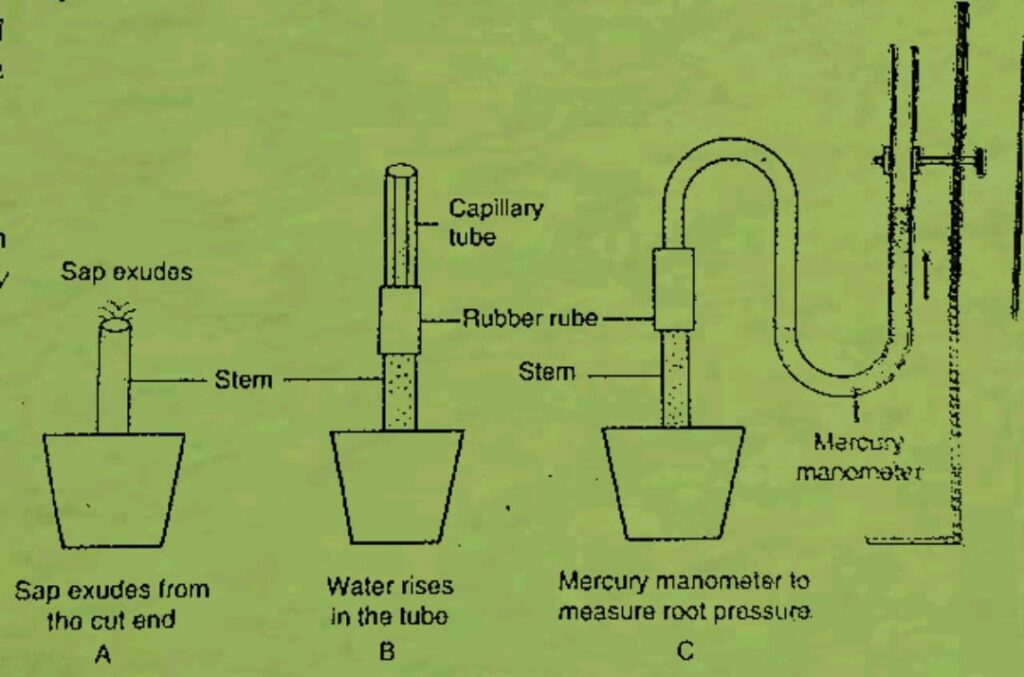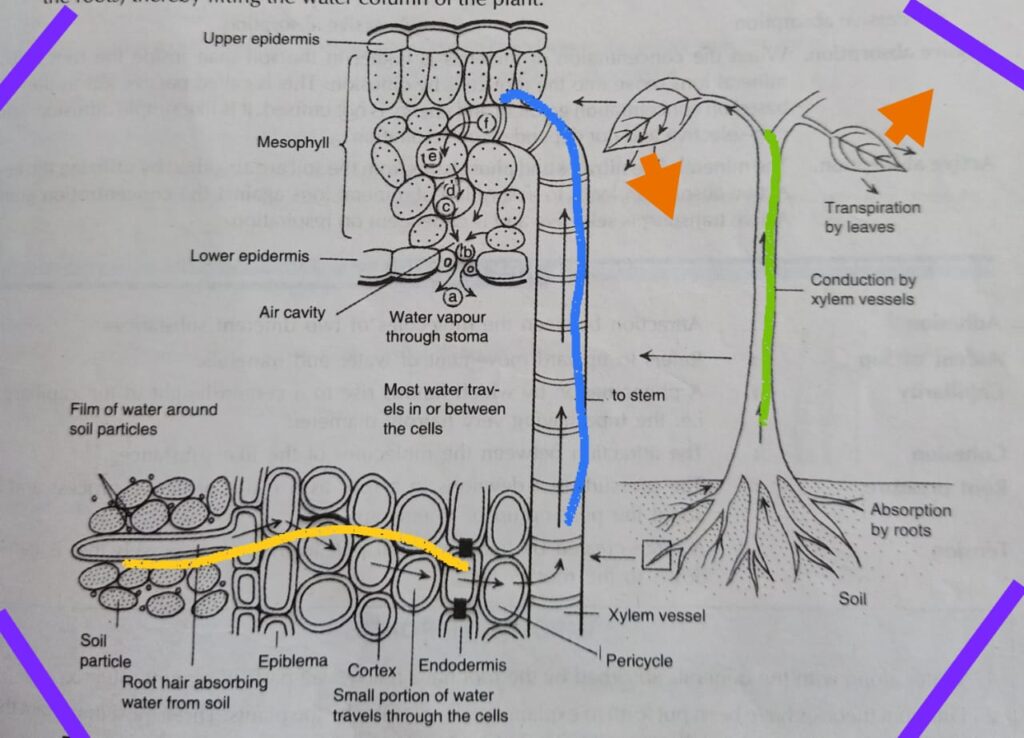ASCENT OF SAP-SCIENCE BLOG
INTRODUCTION
Conduction of water in plants is less elaborate than that of animal as well as plants. Plants are less active, so their cells do not need quick supply of materials. So, the only substances which are to be supplied to a plant through vascular bundle are water and minerals, this process is called ascent of sap. These materials are not available from air. Transport system also helps to carry food prepared in the leaves to the various parts of the plant like stems , roots etc. Ascent of sap is executed by two types of vascular bundles: Xylem which transports water and Phloem which transports prepared food.
TRANSPORTING MATERIAL: These materials are divided into two types:
Water and minerals
Food and other substances like hormone in the plants.
TRANSPORTATION OF WATER AND MINERALS:
Plants require water for making food by photosynthesis. Plants also need minerals salts for various purposes like making proteins. Roots absorb water and minerals from the soil, then it transports to the various parts of the plants like stem, leaves and flowers. Xylem vessels and tracheids help them transportation of water ascent of sap. Both the elements are non-living conducting tissue with thick walls.
TRANSLOCATION OF FOOD AND MINERALS:
Leaves make food which is simple sugar by the process of photosynthesis. The manufactured food is transported to all other parts like branches, stem and roots etc. through a kind of tubes called phloem. It is an element which is a living cells. Phloem contains sieve tube, sieve plate , phloem parenchyma and companion cells.
THEORIES RELATED TO ASCENT OF SAP
ROOT PRESSURE THEORY :
We can see this process by expenditure of energy. Root pressure theory forces the water up through the xylem. It causes exudation cell sap through cut end of stem.The measurement of root pressure theory varies from 3 atmospheric pressure to 8 atmospheric pressure. The reasons of hydrostatic pressure formation are:

- The pressure is not sufficient to raise the water to the top of maximum trees.
- Root pressure theory is absent in conifers, as these maximum are the tallest.
CAPILLARITY THEORY :
Capillarity causes upward movement of water only in the small-sized plants. There is adhesion force between water molecules. This adhesion of water to the surface of the capillary tube pulls water up the tube. But capillarity force can rise the water only few inches.
According to the theory, adhesion between the water molecule and the walls of xylem vessels causes take up of water. Cohesion forces amongst the water molecules causes upward movement of water.
COHESION- TENSION THEORY: It is the most widely accepted theory. It is proposed by Henry Dixon in 1914. It explains how water moves up in the xylem vessels in a plant by water – potential gradient generated by transpiration. This theory we know also as Transpiration pull theory.

According to this, plant loses water from the plant leaf surface. The water escapes as water vapor into the intercellular spaces. Then it releases through stomata into atmosphere.
The sequence of events are:
Evaporation of water from the leaf surface
It reduces the water content in cell walls of mesophyll cells.
The loss of water lowers the water potential of mesophyll cells.
It causes to take up water from the adjacent cells with higher water potential.
Now water loss causes vacuum in the leaf.
Vacuum creates a negative pressure that we term as tension.
This tension lifts the water column of the plant.
The water molecules have strong force of cohesion which has the tendency to stick together.
It creates transpiration pull.
There is an adhesion force between the walls of xylem vessels and water.
This phenomenon provide a possible explanation of lifting of water in the tallest trees.
VERY SHORT TYPE QUESTION ON ASCENT OF SAP (ROOT PRESSURE THEORY) :
Qs1: Which part of plant through which water reaches up to the leaves?
Ans1: Xylem helps water to reach water to the leaves (root pressure theory)
Qs2: Name the term by which water exudes as water droplets at the margins of herbaceous plants due to root pressure.
Ans2: Guttation releases water droplets on the margin of leaf through the organ hydathode working by root pressure theory.
Qs3: Name the strong force of attraction between the water molecule.
Ans3: Cohesion is the force of attraction between the water molecules (root pressure theory) .
Qs4: Name the process of uptake of mineral ions against the concentration gradient using energy from cell.
Ans4: Conduction of water.
Qs5: What is the process of uptake of mineral ions in ascent of sap against the concentration gradient using energy from the cell (root pressure theory)?
Ans5: Active transport helps in transportation of water against the concentration gradient using energy from the cell.
CONCEPTUAL QUESTION ON ASCENT OF SAP (ROOT PRESSURE THEORY):
Qs6: What is capillarity (root preesur theory) ?
Ans6: A phenomenon by which liquids rise to a certain height in the capillary tubes , this tube has very narrow diameter.
Qs7: Define Adhesion (ROOT PRESSURE THEORY)?
Ans7: Attraction between the molecules of two different substances like plant tissue and water molecules we term as adhesion.
Qs8: Elaborate definition of Cohesion (ROOT PRESSURE THEORY)?.
Ans8: The attraction between the molecules of the similar substances like water molecules we term as Cohesion.
Qs9: Define Root pressure theory in ascent of sap?
Ans9: The pressure that develops in a root as a result of active process and brings about the pushing up of xylem sap is root pressure.
Qs10: What is Tension?
Qs10: A force created by the transpiration pull in the xylem vessels which transmits down to the roots is tension .
ANSWER IN SHORT IN ASCENT OF SAP:
Qs11: What is Active Absorption?
Ans11: The plant uses to absorb minerals like nitrates and phosphates from the soil. Plant utilizes the energy in ascent of sap. It leads to absorb mineral ions against the concentration gradient. It is a selective process. It depends upon respiration.
Qs12: Explain Passive Absorption in ascent of sap.
Ans12: When the concentration of minerals is higher in the soil than inside the root cells, the mineral ions move into the root cells by diffusion. This we term as passive absorption. Plant does not utilize concentration gradient and energy. It terms as diffusion. It depends upon respiration.

Thank you for sharing this good article. Very inspiring! (as always, btw)